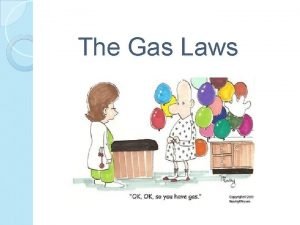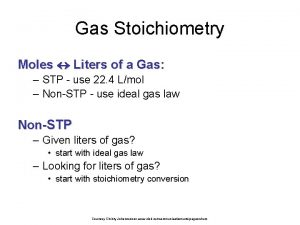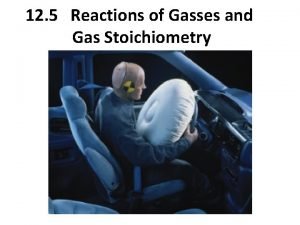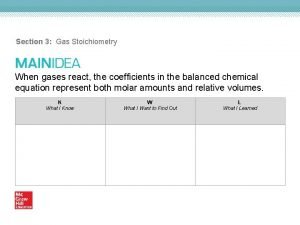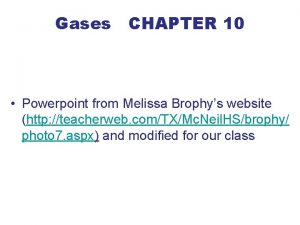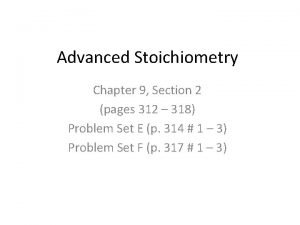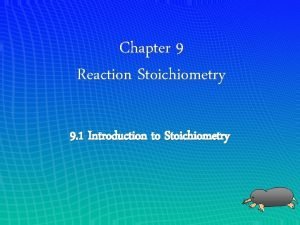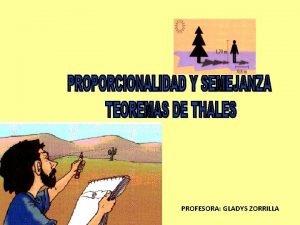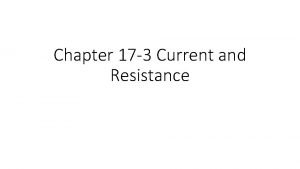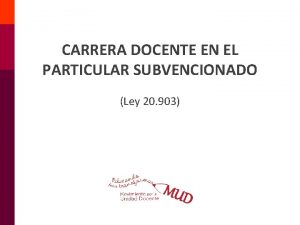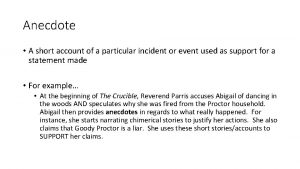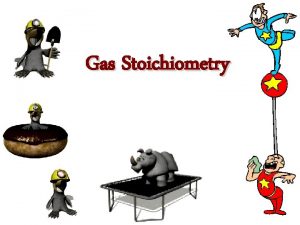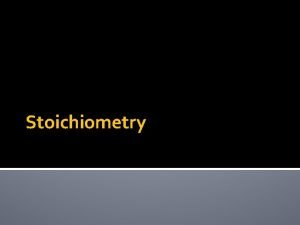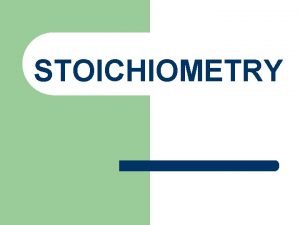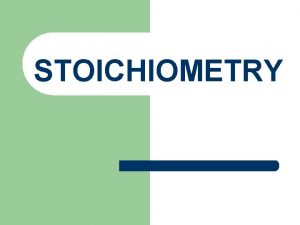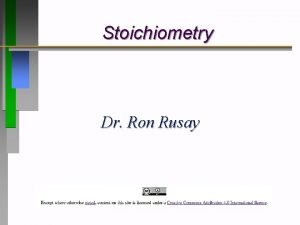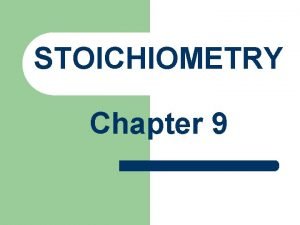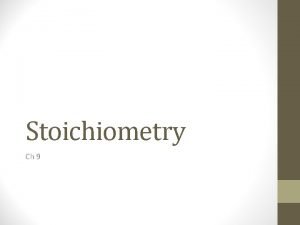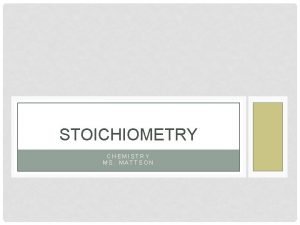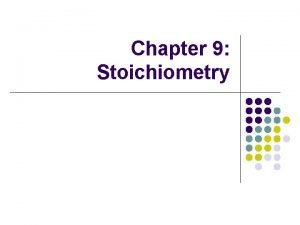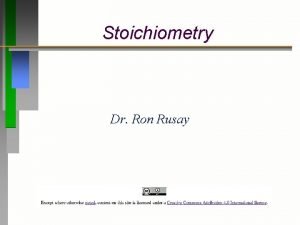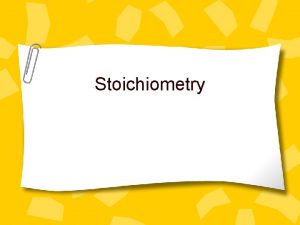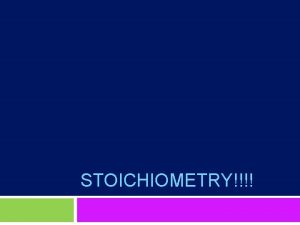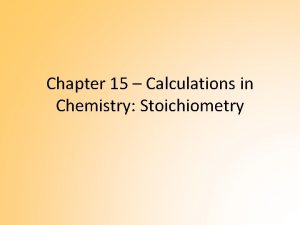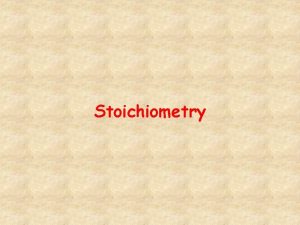Gas Stoichiometry Gas Stoichiometry In this particular section




























- Slides: 28

Gas Stoichiometry

Gas Stoichiometry • In this particular section of chemistry, you will be using the Ideal gas law to help you with your calculations. - In order to use this law properly, you will need to have enough information to solve for the variable that is needed. • You will also need to utilize what you learned in both the regular stoichiometry section and the gas law section. - In order to do so, you will need to use the Periodic table, the balanced chemical equation/reaction, and be able to manipulate equations.

Gas Stoichiometry • Most of all… • You will need to use your brain!!!!!!!!! • Think!

Gas Stoichiometry • • Remember: PV = n. RT P = pressure (k. Pa) V = volume (L) n = number of moles T = temperature (K) R = constant (8. 31 (L· k. Pa)/(K · mol) = 0. 0821 (L – atm)/(K-mol) = when using atm as pressure measurement

Gas Stoichiometry • • Remember: At STP: T = 273 K = Standard Temperature P = 101. 3 k. Pa = Standard Pressure • The following problems are just examples, you will need to apply what you already know to solve the examples you will receive in class.

Converting Between Units of Pressure • A pressure gauge records a pressure of 450 k. Pa. What is this measurement expressed in atmospheres and millimeters of mercury? • Known: • Pressure = 450 k. Pa • 1 atm = 101. 3 k. Pa • 1 atm = 760 mm Hg

Converting Between Units of Pressure • Unknowns: • Pressure = ? atm • Pressure = ? mm Hg 450 k. Pa X 1 atm = 4. 4 atm 101. 3 k. Pa 450 k. Pa X 760 mm Hg = 3400 mm Hg 101. 3 k. Pa

Mole-Volume • How many liters of NH 3 can be produced at a temperature of 27 degrees Celsius and a pressure of 760 mm Hg, if 20 moles of N 2 are consumed? • Known: • N 2(g) + 3 H 2(g) -----> 2 NH 3(g) • T = 27 degrees Celsius • P = 760 mm Hg • 20 moles of N 2

Mole - Volume • Unknown: • Liters of NH 3 = ? • mol N 2 --- mol NH 3 • 20 mol N 2 X 2 mol NH 3 1 mol N 2 = 40 mol NH 3

Mole-Volume • P = 760 mm Hg X 101. 3 k. Pa 760 mm Hg • T = 27˚C + 273 = 300 K • Remember: PV = n. RT • V = n. RT/P = 101. 3 k. Pa

Mole-Volume • V = n. RT / P • V = (40 mol NH 3)(8. 31 (L·k. Pa)/(K·mol)) (300 K) 101. 3 k. Pa = 984. 4 L NH 3

Mass-Volume • How many liters of H 2 will be required at a temperature of 300 K and 3 atm pressure to consume 56 grams of N 2? • Known: • P = 3 atm • T = 300 K • Mass = 56 g N 2 • N 2 + 3 H 2 ------> 2 NH 3

Mass-Volume • Unknown: Liters H 2 = ? • P = 3 atm X 101. 3 k. Pa 1 atm • g N 2 - mol N 2 56 g N 2 X 1 mol N 2 28 g N 2 = 303. 9 k. Pa = 2 mol N 2

Mass-Volume • mol N 2 --- mol H 2 • 2 mol N 2 X 3 mol H 2 1 mol N 2 • mol H 2 -- L H 2 • PV = n. RT = 6 mol H 2

Mass-Volume • V = n. RT/P • V = (6 mol H 2)(8. 31(L·k. Pa)/(K·mol))(300 K) 303. 9 k. Pa = 49. 2 L H 2

Volume-Volume • How many liters of water vapor can be produced if 40 liters of H 2 is consumed in the below chemical reaction when all gases are at the same temperature and pressure? • 2 H 2(g) + O 2 (g) ----> 2 H 2 O (g) • Known: 40 L H 2 • 40 L H 2 X 2 L H 2 O = 40 L H 2 O 2 L H 2

Density of Gases • PV = n. RT • Number of moles = mass/ molar mass • n = mass/molar mass = grams / (grams/mol) = grams X mol / grams = mol m = mass (grams) M = molar mass (grams/mol)

Density of Gases • • • n = m/M Substitute m/M for n PV = m. RT/M Remember density = d = m / V = PM/RT

Density of Gases • • • At STP, what is the density of Cl 2 O 7? Known: Pressure = 101. 3 k. Pa Temperature = 273 K Molar mass Cl 2 O 7 = 183 g/mol

Density of Gases • d = m / V = PM/RT = (101. 3 k. Pa)X(183 g/mol) (8. 31 (L·k. Pa)/(K·mol)) X 273 K) = 8. 17 g/L

Molar Mass • 96. 3 g of a compound occupies 35. 3 liters at 255°C and 0. 874 atm. What is its molar mass? • Known: • Mass = 96. 3 g • Volume = 35. 3 L • Temperature = 255°C + 273 K = 528 K • Pressure = 0. 874 atm X (101. 3 k. Pa/1 atm) = 88. 53 k. Pa

Molar Mass • PV = m. RT/M • M = m. RT/PV • = (96. 3 g)(8. 31 (L·k. Pa)/(K·mol))(528 K) (88. 53 k. Pa)(35. 3 L) = 135. 21 g/mol

Molar Mass and Molecular Formula • 22. 73 grams of a compound is found to occupy 0. 7593 liters at STP. The compound is found to contain 47. 67% Br, 14. 62 % N, and 37. 73 % Na. What is its molecular weight and what is the molecular formula of this compound?

Molar Mass and Molecular Formula • • • Known: Mass = 22. 73 g Volume = 0. 7593 L Temperature = 273 K Pressure = 101. 3 k. Pa 47. 67 Br, 14. 62% N and 37. 73% Na

Molar Mass and Molecular Formula • Calculate empirical formula: 47. 67 g Br X 1 mol Br = 0. 60 mol Br 79. 9 g Br 14. 62 g N X 1 mol N 14. 0 g N = 1. 04 mol N 37. 73 g Na X 1 mol Na = 1. 65 mol Na 22. 9 g Na

Molar Mass and Molecular Formula • Empirical Formula = lowest number is 0. 60 mol • 0. 60 mol Br / 0. 60 mol = 1 X 4 = 4 • 1. 04 mol N / 0. 60 mol = 1. 73 X 4 = 7 • 1. 65 mol Na / 0. 60 mol = 2. 75 X 4 = 11 • Na 11 N 7 Br 4 = empirical formula • Formula mass = 670 g/mol

Molar Mass and Molecular Formula • Remember: • M = m. RT/PV = (22. 73 g)(8. 31 (L·k. Pa)/(K·mol))(273 K) (101. 3 k. Pa)(0. 7593 L) = 670 g/mol

Molar Mass and Molecular Formula • Molar mass of Molecular formula = 670 g/mol • Formula mass of Empirical formula = 670 g/mol • They are the same! • 670/670 = 1 • 1(Na 11 N 7 Br 4) = Na 11 N 7 Br 4
 Gas stoichiometry worksheet
Gas stoichiometry worksheet Gas stoichiometry
Gas stoichiometry Gas stoichiometry worksheet answers
Gas stoichiometry worksheet answers Gas stoichiometry
Gas stoichiometry Stoichiometry of gases
Stoichiometry of gases State and prove dalton's law of partial pressure
State and prove dalton's law of partial pressure Modern chemistry chapter 9 stoichiometry
Modern chemistry chapter 9 stoichiometry Chapter 9 review stoichiometry section 2
Chapter 9 review stoichiometry section 2 Stoichiometry example
Stoichiometry example Chapter 9 review introduction to stoichiometry
Chapter 9 review introduction to stoichiometry Pseudo reduced specific volume
Pseudo reduced specific volume Imaginary gas
Imaginary gas Gas law
Gas law Sutherland's law
Sutherland's law Conclusion on bhopal gas tragedy
Conclusion on bhopal gas tragedy Gas leaked in bhopal gas tragedy
Gas leaked in bhopal gas tragedy Gas reale e gas ideale
Gas reale e gas ideale Flue gas desulfurisation gas filter
Flue gas desulfurisation gas filter Poisonous gas leaked in bhopal gas tragedy
Poisonous gas leaked in bhopal gas tragedy Difference between ideal gas and real gas
Difference between ideal gas and real gas Persamaan arrhenius
Persamaan arrhenius Gas exchange key events in gas exchange
Gas exchange key events in gas exchange A particular panda consumes 1944 calories
A particular panda consumes 1944 calories Teorema general de thales
Teorema general de thales Why did the german soldiers come to uncle henrik’s house
Why did the german soldiers come to uncle henrik’s house In a particular television tube the beam
In a particular television tube the beam Como se calculan los bienios en la carrera docente
Como se calculan los bienios en la carrera docente Short account of an incident
Short account of an incident Particular fussy subservient
Particular fussy subservient
